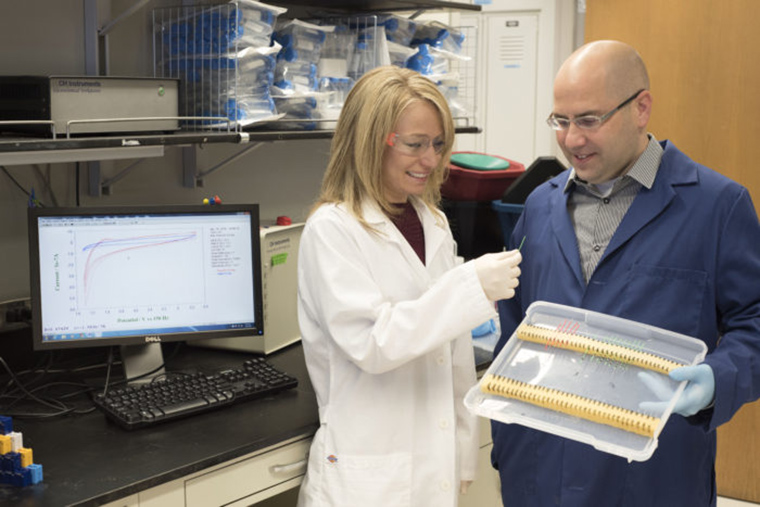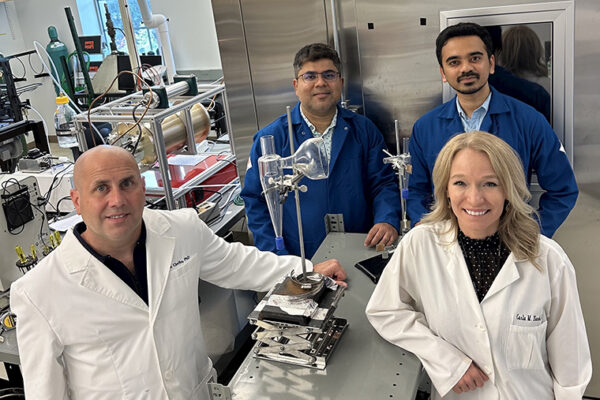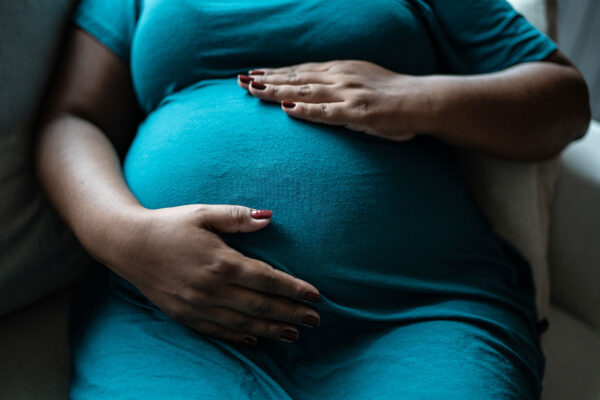Imagine the ability to quickly and accurately diagnose if you are infected with influenza, respiratory syncytial virus (RSV) or COVID-19 with one breath in less than a minute. A team of researchers at Washington University in St. Louis is developing an inexpensive, handheld breathalyzer that could make rapid screening a step closer to reality.

Rajan Chakrabarty, the Harold D. Jolley Career Development Associate Professor of Energy, Environmental & Chemical Engineering at the McKelvey School of Engineering, and John Cirrito, professor of neurology at the School of Medicine, will adapt their COVID-19-detecting breathalyzer to one that can also screen for influenza A and RSV with a two-year $3.6 million grant from Flu Lab, an organization that funds efforts to defeat influenza. With the funding, they plan to take the technology from bench into clinical trials at Washington University’s Infectious Disease Clinical Research Unit with the goals of design and specifications for commercial application and preparing the breath test for FDA registration.

COVID-19, RSV and influenza A are the most predominant of seasonal viruses, each transmitted through aerosols and droplets that are easily spread indoors. Influenza A infects up to 40 million people in the U.S. annually, and RSV can hospitalize 240,000 children and older adults. While preferable to diagnose viruses early, the viral load is often low in the early stages of the disease, requiring a rapid and sensitive test. An accurate diagnostic device that provides fast sampling and test results and could identify multiple viruses even at early stages would reduce time to treatment and lead to earlier decisions by individuals to isolate, more efficiently protecting households, communities and businesses.
“The testing options available now are not the aerosol itself, but biomarker tests, which is an indirect detection,” said Chakrabarty, an aerosol scientist. “The second disadvantage is that the commercially available devices are bulky, and a patient tires out blowing into it, so it’s not user-friendly. We really focused on the design of our exhaled breath collection unit to include the best of both worlds.”
The work stems from a breathalyzer the team developed for COVID-19 that was detailed in ACS Sensors in July 2023. To conduct the breath test, the researchers insert a straw into the device. A person blows into the straw, and aerosols from the person’s warm breath collect on a cold surface inside the device, which are then read by the biosensor. The device then is plugged into a small machine that reads signals from the biosensor. In less than a minute, the machine reveals a positive or negative finding of COVID-19, and potentially, RSV and influenza A.
The device uses a biosensor adapted from an Alzheimer’s disease-related technology developed a decade ago by Cirrito and Carla M. Yuede, an associate professor of psychiatry at the School of Medicine. Cirrito and Yuede used a nanobody — an antibody from llamas — to detect the virus that causes COVID-19. The researchers began working on the breath test device — made with 3D printers — after receiving a grant from the National Institutes of Health (NIH) in November 2020.
“For COVID, we got a nanobody from David Brody, who used to be at Washington University and is now at the National Institutes of Health,” Cirrito said. “We will make new nanobodies to detect influenza A and RSV. But ultimately the biosensors can be adapted for all kinds of airborne pathogens, including other viruses or even bacteria and fungi.”
Each COVID-19-specific test should cost less than $20, leading Chakrabarty to estimate an even lower cost for a combined test when produced in larger quantities.
The team will work with design firm TE Connectivity to adapt the current research prototype that detects COVID-19 into the multi-pathogen device that can be tested for an FDA clinical trial and eventually commercialized.
While the initial device will be built to detect the three most common seasonal viruses, the team plans to include other pathogens, emerging pathogens or bioterror threats in future designs, which could be useful for the military or the federal government.
“The team is very excited to take something we developed in the lab and finally have an avenue to make it a real product so people around the world can use it,” Chakrabarty said. “A rapid breath diagnostic that would screen a large group of people for viruses could seriously reduce disease spread in crowds. Or rapidly diagnosing which respiratory virus someone has in a clinic means they could get the right medicine immediately instead of waiting hours or even days before they could get treated and start feeling better.”
The team is working with the university’s Office of Technology Management to license the technology for potential commercialization and has continued development support from the NIH. In addition, Y2X Life Sciences, a New York-based company, has an exclusive option to license the technology. That company has consulted with the research team from the beginning of the project and during the device’s design stages to facilitate commercialization of the test in the future.
Originally published on the McKelvey School of Engineering website. The work of Jim Dryden contributed to this piece.


